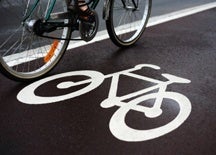Building routine activity into daily life means changing the way that our communities are built. Community designs that discourage urban sprawl, prioritize recreation space, and facilitate safe walking and biking can increase everyday opportunities to be active. So can improvements to public transportation, since in the U.S., nine out of 10 public transit trips involve walking at the start or end of the route. While many of these land use and transportation changes take place at the local level, all levels of government play a role. The key is to connect planning and development to public health.
Here is a summary of community planning, design, and transportation strategies to promote walking, bicycling, and active lifestyles. It’s based on a review of expert guidance from the Institute of Medicine, the U.S. National Physical Activity Plan, and others. For more detailed guidance on these recommendations and ideas for putting them into practice, explore the source list and the links to other resources.
Make increased physical activity a priority in the planning of new development and transportation projects, such as by incorporating Health Impact Assessments(1, 2, 3, 4)
Adopt zoning policies, such as allowing residential and commercial uses near each other (mixed-use development), that promote active transportation to destinations and make it easier to access physical activity and recreation areas(4, 5)
Create policies that encourage new schools to be sited in locations that allow children to bike and walk to school(2, 4, 5, 6)
Incorporate Safe Routes to Schools and Safe Routes to Worksites, such as Bike-to-Work, into transportation planning, to encourage bicycling and walking to school and work(3, 4, 6)
Improve the infrastructure for walking and biking, to promote active transportation(3, 5, 6)
- Walking infrastructure: Sidewalks, pedestrian crossings, trails
- Bicycling infrastructure: Dedicated protected bike lanes (cycle tracks), countdown bicycle crossing signals, bike racks (7)
Adopt traffic calming street design standards and elements to reduce vehicle speed and promote safe bicycling and walking, for all ages(1, 3, 6)
Improve access to and use of public transportation, such as by offering reduced fares and improved service(5, 6)
Community Design and Active Transportation-Source List
1. National Prevention Council. National Prevention Strategy. Washington, D.C.: U.S. Department of Health and Human Services, Office of the Surgeon General; 2011.
2. White House Task Force on Childhood Obesity. Solving the Problem of Childhood Obesity within a Generation.Washington, D.C.: White House Task Force on Childhood Obesity; 2010.1. National Prevention Council. National Prevention Strategy. Washington, D.C.: U.S. Department of Health and Human Services, Office of the Surgeon General; 2011.Community Design and Active Transportation-Source List
3. National Physical Activity Plan. National Physical Activity Plan for the United States. 2010. Accessed February 2, 2012.
4. Institute of Medicine. Preventing Childhood Obesity: Health in the Balance. Washington, D.C.: The National Academies Press; 2005.
5. Keener D, Goodman K, Lowry A, Zaro S, Kettel Khan L. Recommended community strategies and measurements to prevent obesity in the United States: Implementation and measurement guide.Atlanta: U.S. Dept. of Health and Human Services Centers for Disease Control and Prevention; 2009.
6. IOM (Institute of Medicine) and National Research Council. Local Government Actions to Prevent Childhood Obesity. Washington, D.C.: The National Academies Press; 2009.
7. The Center for Research and Contract Standardization in Civil Engineering (CROW).CROW-Record 25: Design Manual for Bicycle Traffic. Ede, The Netherlands: CROW; 2006.
